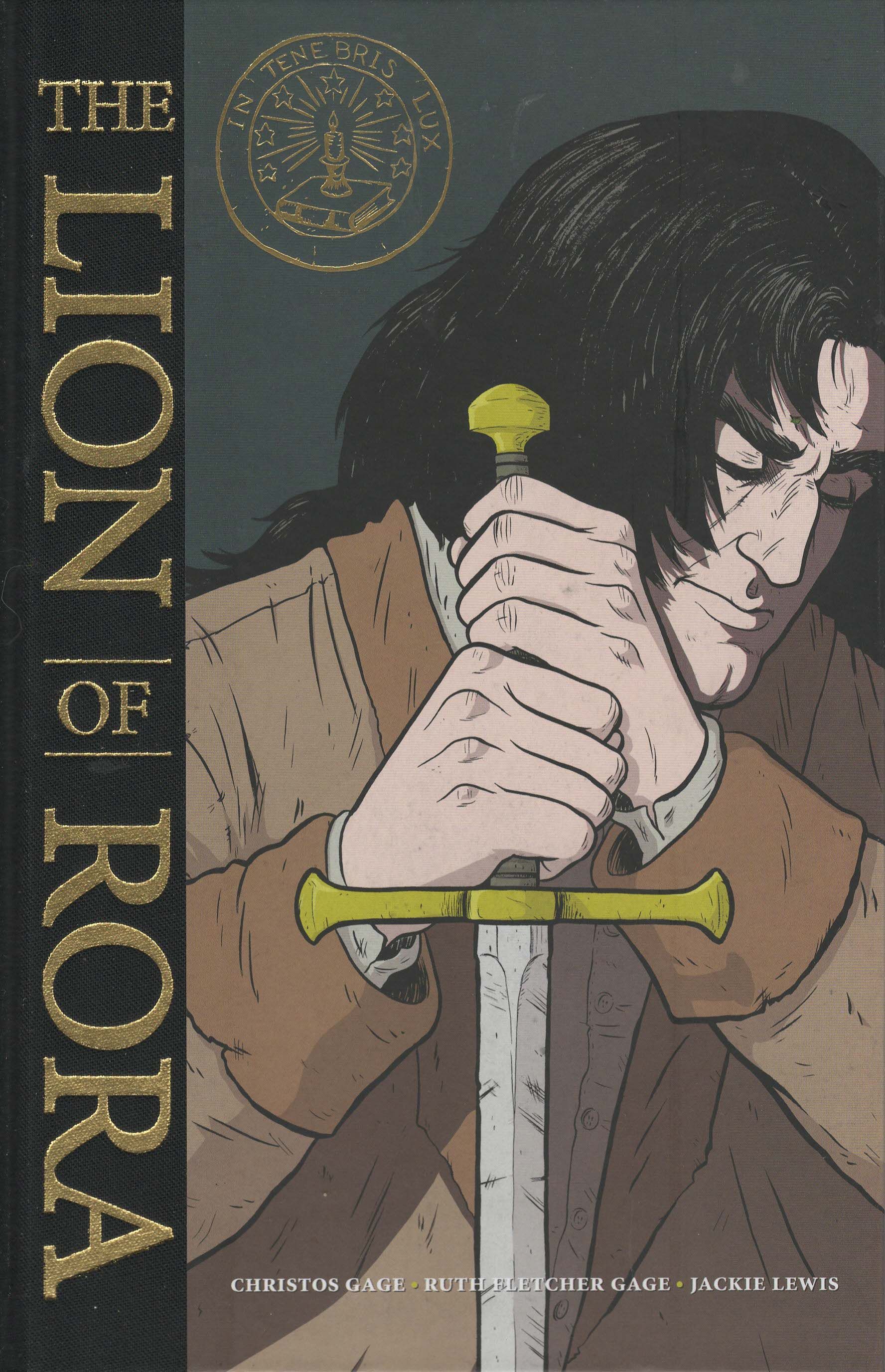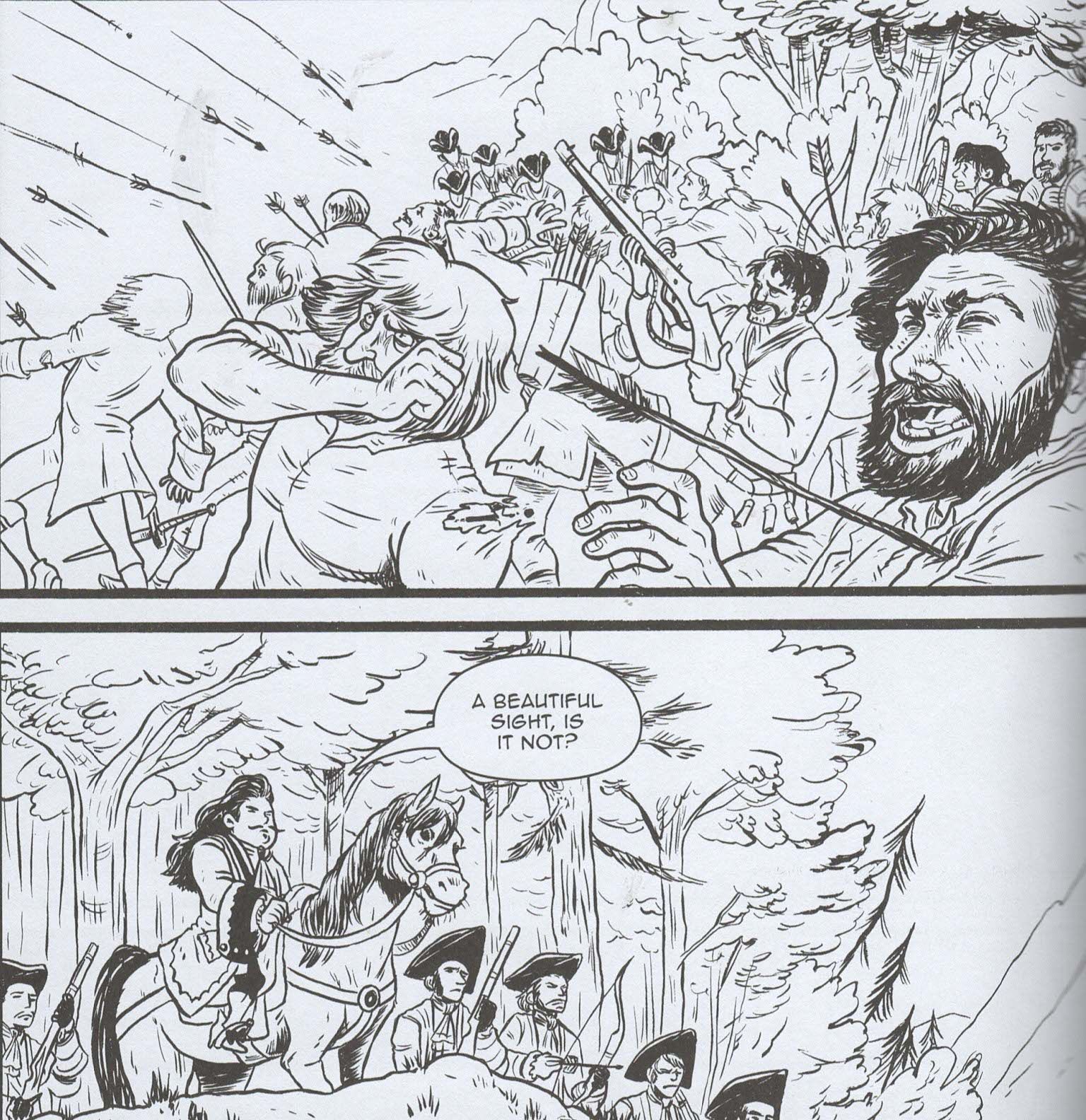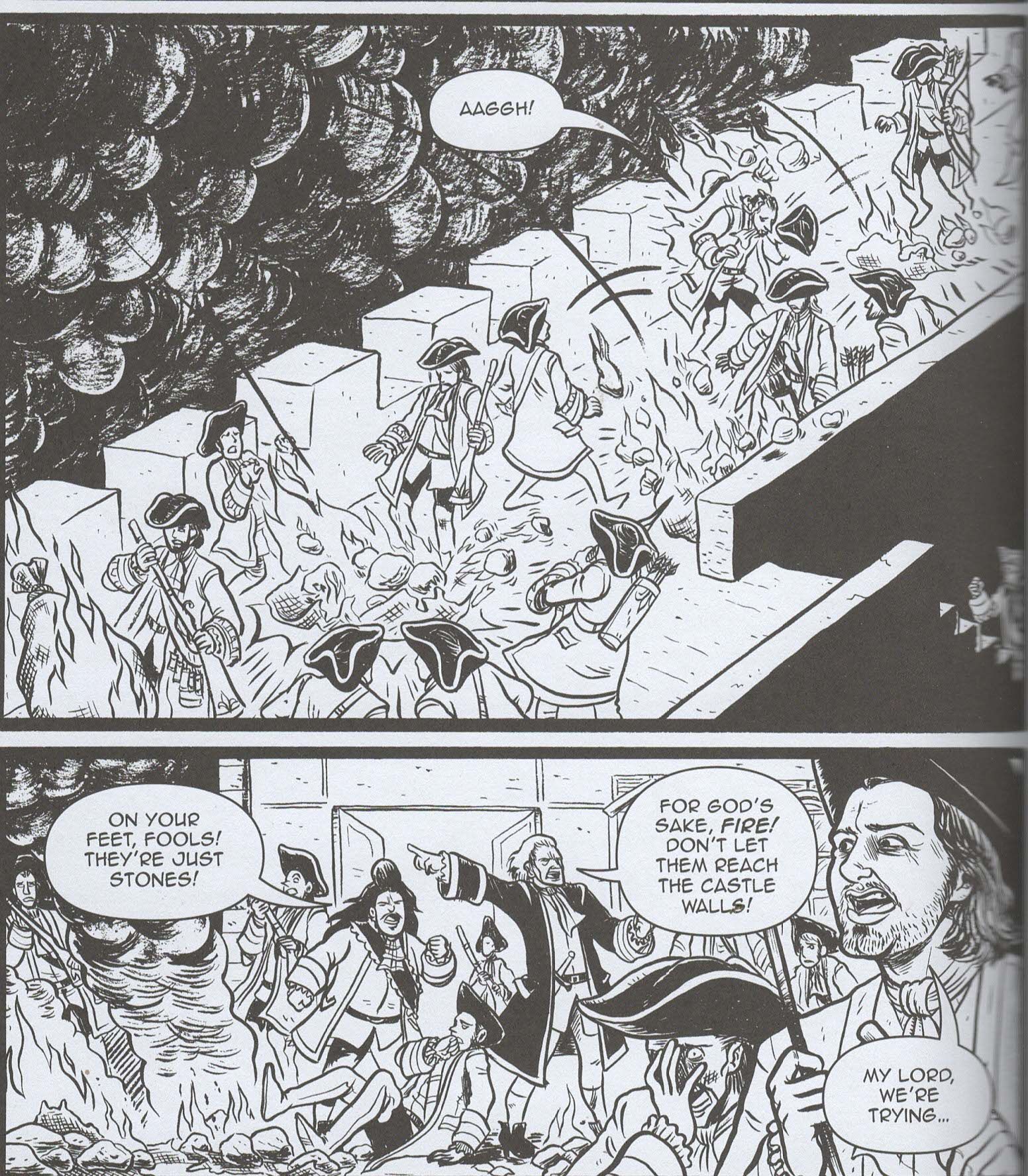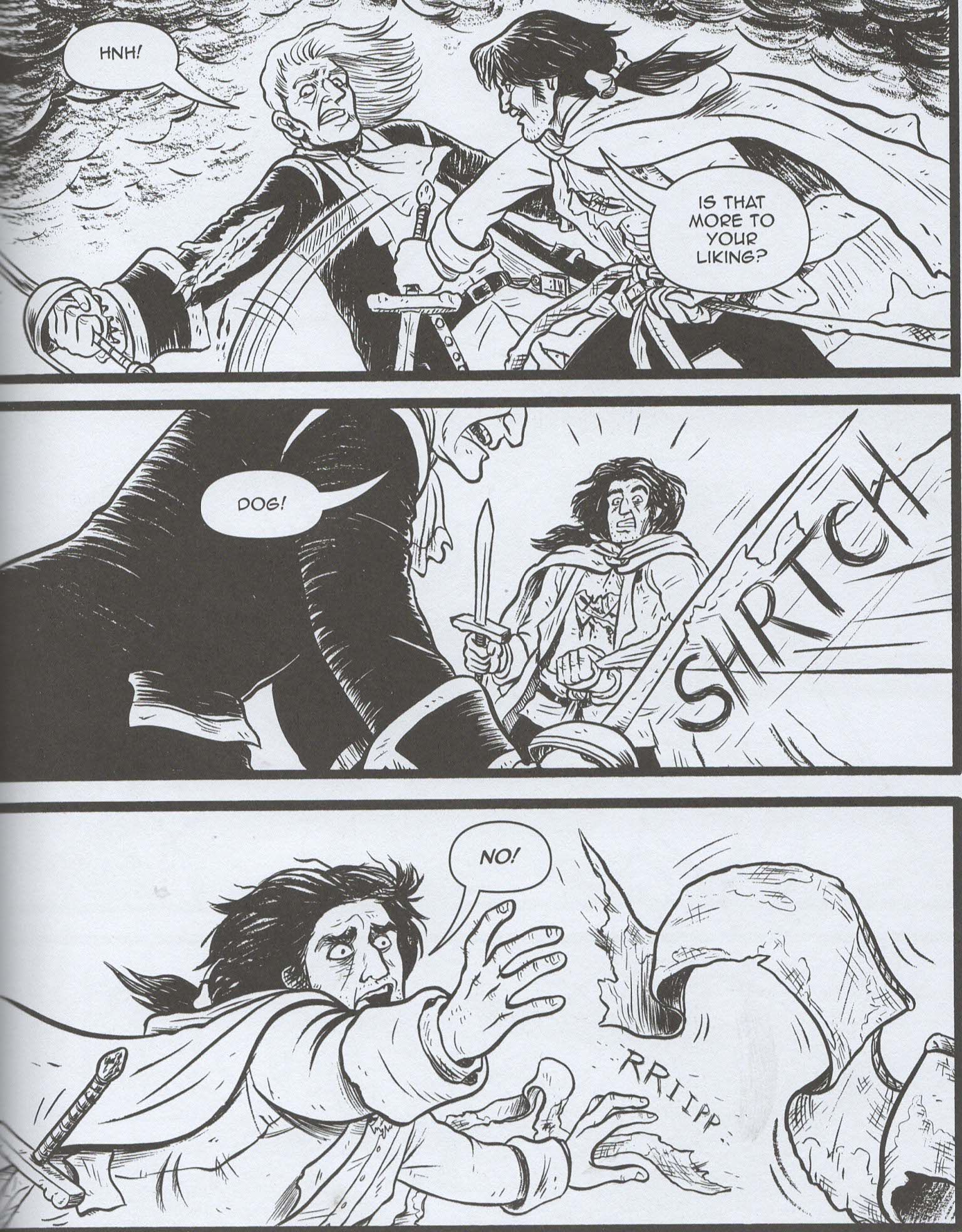"If I need security, I'll keep a gun on me"
When I read about The Lion of Rora in Previews, I knew I was going to get it. It's right in my wheelhouse, after all - it's historical fiction, it's set during a fascinating time in history (the 1600s), and it takes place in an obscure corner of Europe (Savoy). Plus, Christos Gage is a decent writer, and while I don't know much about his wife, Ruth Fletcher Gage, she writes a lot for television, so there's that.
Jackie Lewis drew this, Jenny Vy Tran lettered it, James Lucas Jones edited it, Oni published it, and it costs $24.99. That's what you need to know!
The titular hero of the book is Joshua Janavel, an Italian Waldensian who lived from 1617 to 1690. The Waldensians are a sect founded in the 1100s that during the Reformation became Calvinist, which during the 17th century meant that staunchly Catholic Italy and France didn't really dig them. They lived mainly in Savoy, which is wedged between Italy and France (yes, I know Italy didn't exist in the 1600s, but bear with me - I mean "Italian-speaking territories") and was often under pressure from the French, considering it was technically part of the German-oriented Holy Roman Empire. Lots of stuff going on, in other words. Janavel became the de facto leader of the Waldensians in 1655 when Duke Charles Emmanuel II tried to exterminate the Waldensians in his territory, and he was able to fight a mildly successful guerrilla war against the Savoyards for years before he was finally forced into exile in Switzerland. It's a good story, and it's not surprising that the Gages wanted to tell the story, especially as Ruth's mother - as she says in the acknowledgements - was "dedicated" to Waldensian history and was possibly related to one of the participants in the uprisings.
Unfortunately, they don't quite make it as good as it could be.
One thing you might recall bugs me about history books is that historians aren't terribly good writers. They often think the events of whatever they're writing about are interesting enough to carry the day, and if you're writing academic history for scholars to study, you're probably correct. If you're writing something that you want to be more popular history, you need to figure out a way to make it interesting for the layperson. I love history, and even I get bored with some of the writing I find in ostensibly "popular" history books. That shouldn't be a problem for Gage, who writes fiction, but he still falls into the trap of historical writing, giving his characters bland personalities and big speeches about how they feel and what they should do. He twists history quite a bit (if the Internet is to be believed; I've never actually read a history of the Waldensians or Janavel), but that's not the worst thing to do in historical fiction. What is a bit of a sin is that Janavel and the others aren't very well constructed characters - Janavel is wholly good, while the duke and his top minion are cartoonishly evil, and Gage perhaps doesn't want to delve into the complicated world of Reformation Europe, but the situation in Savoy is not explained terribly well. In the first scene of the book, Janavel is a boy and his family is killed, providing him with all the motivation he needs later in life. But it also turns him into a bland orator, one who makes nice speeches but who doesn't have much of a personality otherwise.
His wife and son remain ciphers - they exist so that the duke, twirling his mustache, can imprison them to use as leverage over Janavel. He never says anything that's not perfect - early on, he says:
This is not about revenge, or land. The Duke wants something far greater than our property. He wants to take our right to think, to believe. He wants us to live in fear. He wants us to lose the hope that we can ever have a better life. We have lived thus far according to the duke's dictates, rather than our conscience. Have we ever had peace? Have we ever had a home? No more. We may not win. We may well perish. But we must send a message to this sovereign that our hearts, our minds, and our souls are our own. And we will die before we let any man rule them!
That's a nice speech, but here's the thing: This is how he always talks. He always talks as if he's making a speech, and it's always very dramatic. It become tiresome, and it makes Janavel far less interesting than he probably was, because he's too perfect. If he was the military genius the Gages portray him as, that's fine, but he seems sui generis, and the book would be a lot more interesting if we got some idea why he was such a great tactician. The villains, as cartoonish as they are, are far more interesting - the duke is a sniveling weakling who cowers before the far more powerful king of France, Louis XIV, mainly so he can remain somewhat independent (the Gages, however, never name the duke or the king, so I'm just going by the actual rulers of the time, even though Charles Emmanuel was never Louis's brother-in-law, as he is in the comic).
The duke's attempts to keep Savoy away from the influence of France are fascinating, but they're barely touched upon because Janavel is the star of the book. The Waldensians' Calvinism and the whole mess of the Reformation is also an interesting story, but again, the Gages are too interested in making their hero angelic to delve into the concerns Catholics had about Protestants and their tendency to equate religious reform with political reform (as politics and religion were entwined far more then than they are today) or the concerns Protestants had about Catholics persecuting them. The Gages want us to believe that the resistance of the Waldensians was inspirational across Europe, but except for a reference to a Milton sonnet and a mention of Oliver Cromwell, we get no sense of that. There's another villain in the book who seems to be friendly to the Waldensians' cause, and while he's a jerk, he makes reference to why he's acting the way he does, which of course is utterly dismissed by Janavel and the authors. It's not that he's actually noble and they besmirch his name, it's that everyone in the book but Janavel seems to live in the real world and understand realpolitik, and for that they're excoriated while Javanel is beatified and therefore much less interesting. It's too bad, as individual sections of the book are terrific - whenever there's fighting, the Gages do an excellent job placing us into the action and showing how well Javanel uses his "home-field advantage" to defeat the invaders, the battle of the bridge is a superb moment even though it's really predictable, and Javanel's rescue of his family from the duke's castle is a wonderfully elaborate set piece.
So it's an entertaining comic for the most part, but it's clear the Gages want it to be something more than that as well, and they don't quite get there.
It's also too bad because Lewis's art is so good. She hasn't done much comics work, but she does an excellent job. She does a great job with the way people dress, so that Janavel, despite being poor, looks noble because he takes pride in his appearance, and of course his rustic, simple clothing (and those of the other Waldensians) is in nice contrast to the long coats, breeches, and jewelry of the nobility. Even the men's facial hair is clever, as the Waldensians are either stubbly or fully bearded (which today means they're rugged and trustworthy), while the duke has a Snidely Whiplash mustache, so we know he's evil. The Alpine scenery of Janavel's home is nicely done, as Lewis shows very clearly why Janavel was able to take advantage of the landscape to defeat forces significantly larger than his. When Janavel is seriously wounded in the book, Lewis does a wonderful job showing him struggling to rise and fight back, and that leads to the battle at the bridge, which is only a few pages long but is amazingly intense. Despite some of the clichés in the story (Janavel fighting the bad guy while trying to save his family comes to mind), Lewis makes each moment bristle with excitement, as her choreography during the fights is terrific and easily followed. She uses blacks really well, making the mountains menacing as the Catholics march through them, as if the landscape itself has turned against them.
We get a good sense of how brutal warfare was when it was fought with swords and arrows, as Lewis doesn't shy away from showing the harshness of battle even though the book is not gory at all. She doesn't get a chance to be too fancy with the layouts, but the drawing in the book is top-notch.
As usual with books that I want to like, it really bugs me that The Lion of Rora isn't better. It's a story worth telling, and it features as potentially great character, and it looks great, but it's frustrating that the Gages take the most bland aspects of the story and highlight that. Making Janavel as perfect as possible doesn't make the book better, it makes it far less interesting because there's no reason to care all that much about his struggle - he's right, everyone who opposes him is evil, and he'll naturally win because of that. Even though he doesn't technically "win," he still does because he's so perfect. It's a frustrating comic, because it feels like the Gages knew they had a good story and didn't trust it, instead trying too hard to stack the deck in Janavel's favor. It's a comic I'm glad I read, and it's certainly educational (even though, as I noted above, the Gages skew a lot of the history), but it's less than the sum of its parts, which is too bad.
Rating: ★ ★ ★ ★ ★ ½ ☆ ☆ ☆ ☆







